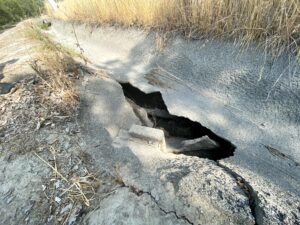by Todd Bishop
Sacramento Valley Mirror
posted April 20, 2022
Glenn County — State and local officials have been quietly looking into the emergence of numerous sinkholes starting last summer and fall on agricultural land east of Orland, in the area of Stony Creek, according to newly released public records.

Many of the sinkholes are relatively small and shallow, a few feet wide and less than a foot deep, for example. However, there are isolated reports of bigger sinkholes, as wide as 10 to 12 feet.
“The deepest is about 12 to 15 feet in depth — literally, a small child could have entered the tunnel that I observed at the bottom of that hole,” wrote Rick Massa, manager of the Orland Unit Water Users’ Association (OUWUA), in a Nov. 8 email to officials with Glenn County and the California Department of Water Resources after a follow-up visit to one hard-hit property.
The records — including email messages, photos and preliminary analyses — were released by the state and county in response to a public records request by AquAlliance, a Chico-based watchdog group focused on Northern California water issues.
The sinkholes are raising new concerns in a part of California that has largely avoided the land subsidence caused by groundwater pumping in the central and southern regions of the state.
On one property in the Orland area, more than 90 sinkholes were counted last fall, the records show. On another, a landowner needed six trailer loads of material to refill one sinkhole.

The messages between state and local officials offer a variety of initial theories about the potential cause of the sinkholes, including the possible impact of groundwater pumping and severe drought on underlying water levels, contributing to instability of soil and gravel.
However, the actual cause of the sinkholes “is still unclear,” said Michelle Dooley, a DWR supervising engineering geologist based in the agency’s Red Bluff office, responding via email to the Valley Mirror’s request for an update on the situation this week.
Barbara Vlamis, AquAlliance executive director, said she is reserving judgment about the cause of the sinkholes. However, she said the issue deserves greater scrutiny and transparency, particularly in light of water transfers by districts where growers are relying in part on groundwater for irrigation.
Groundwater pumping has “potentially created great stress on the shared aquifer, and there’s no responsibility or even an answer provided by the agencies that oversee transfers or those that participate in the transfers,” Vlamis said.
State and federal agencies need to commission studies by scientists who are “outside the transfer marketing scheme, to start looking into this immediately, and provide everyone with some semblance of an answer,” she said, calling it “unconscionable” that the public has been in the dark about the issue.
In October, state and local officials went on a field trip to several sites that were experiencing sinkholes east of Orland, after Massa of the OUWUA alerted them to the issue.
Using California drought funding, DWR plans to study the issue by installing telemetered dataloggers in a DWR multi-completion monitoring well on the property of a landowner who has since reported a sinkhole problem near Hamilton City, Dooley said.
Glenn County Supervisor Grant Carmon said the issue is on the county’s radar, with the possibility of seeking additional funding to study what is causing the sinkholes.
Longtime Orland-area resident Dwight Foltz, a former Glenn County Supervisor, recalled smaller sinkholes in the area during the historic 1976-77 drought and at least one other time. However, the public records indicate more widespread and larger sinkholes this time.
The issue comes as the region enters a third year of drought. Glenn County logged nearly 200 dry domestic wells countywide in 2021, including many in and around the Orland area. Landowners in most cases have been filling in sinkholes using material such as soil and gravel.
The main impact of the sinkholes so far has included “difficulties to farming operations as people walk and drive equipment around the areas and also instability to the root systems of trees located near the sinkholes,” Dooley of the DWR said this week.
In an email to state and local officials in November, Dooley called the Orland-area sinkholes “perhaps the most intriguing geologic issue many of us have encountered in several years.”
Ken Loy, a hydrogeologist with West Yost Associates who consults with the Colusa and Glenn groundwater sustainability agencies, wrote in an email to others following the issue that his research identified only one other occurrence, in Italy, of sinkholes in alluvial soils such as those in the Stony Creek area, formed by loose sand and gravel deposited by running water in a stream bed.
Sinkholes are more common in what’s known as karst terrain, such as salt beds and limestone, where groundwater naturally dissolves the rock beneath the surface.
The Colusa and Glenn groundwater authorities in January submitted to DWR their long-term plan for groundwater conservation and recharge in the region under the California Sustainable Groundwater Management Act (SGMA).
AquAlliance, the California Sportfishing Protection Alliance and the California Water Impact Network have filed a lawsuit alleging that the plan fails to meet the requirements of the law.
This story was published earlier today in the Sacramento Valley Mirror. Writer Todd Bishop is a journalist who grew up in Orland and volunteers for the Mirror. A Seattle-based business and technology reporter, he co-founded the tech news site GeekWire. Contact him at todd@geekwire.com or at 530-230-3439.

While additional studies are welcome, it seems clear that excessive pumping of the aquifer by agrobusiness in this time of extreme drought is the issue. With outdated water rights laws and a laissez-faire attitude on the part of elected officials we are heading toward catastrophe.